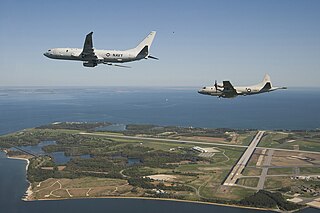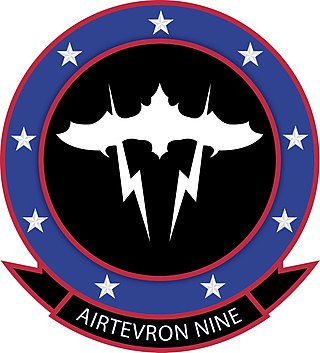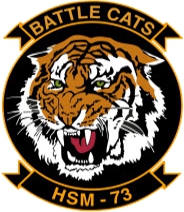
The Lockheed S-3 Viking is a four-crew, twin-engine turbofan-powered jet aircraft designed and produced by the American aerospace manufacturer Lockheed Corporation. Because of its characteristic sound, it was nicknamed the "War Hoover" after the vacuum cleaner brand.

The Northrop Grumman MQ-4C Triton is an American high-altitude long endurance unmanned aerial vehicle (UAV) developed for and flown by the United States Navy as a surveillance aircraft. Together with its associated ground control station, it is an unmanned aircraft system (UAS). Developed under the Broad Area Maritime Surveillance (BAMS) program, the Triton is intended to provide real-time intelligence, surveillance and reconnaissance missions (ISR) over vast ocean and coastal regions, continuous maritime surveillance, conduct search and rescue missions, and to complement the Boeing P-8 Poseidon maritime patrol aircraft.

Naval Air Station Patuxent River, also known as NAS Pax River, is a United States naval air station located in St. Mary’s County, Maryland, on the Chesapeake Bay near the mouth of the Patuxent River.

Naval Base Ventura County (NBVC) is a United States Navy base in Ventura County, California. Formed by the merger of NAS Point Mugu and CBC Port Hueneme, NBVC is a diverse installation composed of three main locations — Point Mugu, Port Hueneme, and San Nicolas Island. The base serves as an all-in-one mobilization site, deep water port, railhead, and airfield. NBVC supports more than 100 tenant commands with a base population of more than 19,000 personnel, making it the largest employer in Ventura County.
VX-4, Air Test and Evaluation Squadron Four,, commonly referred to by its nickname of The Evaluators, was a United States Navy air test and evaluation squadron based at Naval Air Station Point Mugu, California. Their tail code was XF, and they flew the McDonnell Douglas F-4 Phantom, Grumman F-14 Tomcat and the McDonnell Douglas F/A-18 Hornet until their disestablishment in 1994.

Air Test and Evaluation Squadron Nine is a United States Navy air test and evaluation squadron based at Naval Air Weapons Station China Lake, California. Using the tail code XE, the squadron operates F/A-18E/F Super Hornets and EA-18G Growlers.

The Operational Test and Evaluation Force (OPTEVFOR) is an independent and objective agency within the United States Navy for the operational testing and evaluation (OT&E) of naval aviation, surface warfare, submarine warfare, C4I, cryptologic, and space systems in support Navy and Department of Defense acquisition programs.
Naval Air Warfare Centers are research organizations within Naval Air Systems Command. The centers are grouped within the following divisions:

VX-20, Air Test and Evaluation Squadron Twenty, is a United States Navy air test and evaluation squadron based at Naval Air Station Patuxent River, Maryland.

Air Test and Evaluation Squadron TWO ONE (HX-21) "Blackjack" is a U.S. Navy aircraft squadron located at Naval Air Station Patuxent River, Maryland on the Chesapeake Bay. As part of the Naval Air Warfare Center Aircraft Division (NAWC-AD), Naval Test Wing Atlantic (NTWL), HX-21 is responsible for the Developmental Test and Evaluation of Navy and Marine Corps rotary-wing/tilt-rotor aircraft, airborne systems, and Unmanned Aircraft Systems (UAS) in support of acquisition decisions that improve the Navy and Marine Corps' war fighting capability. Additionally, HX-21 tests and evaluates new mission systems to integrate legacy aircraft into the constantly evolving fighting force.

Helicopter Maritime Strike Squadron 49 (HSM-49) is a United States Navy Maritime Strike helicopter squadron based Naval Air Station North Island, California.

VP-49 was a long-lived Patrol Squadron of the U.S. Navy, having held that designation for 45 years from 1948 to 1994. Its nickname was the Woodpeckers from 1973 to 1994. It was established as VP-19 on 1 February 1944, redesignated Patrol Bombing Squadron VPB-19 on 1 October 1944, redesignated VP-19 on 15 May 1946, redesignated Medium Patrol Squadron (Seaplane) VP-MS-9 on 15 November 1946, redesignated VP-49 on 1 September 1948 and disestablished 1 March 1994.

Patrol Squadron 30 (VP-30) is a maritime patrol squadron of the United States Navy, established on 30 June 1960. It is based at Naval Air Station Jacksonville, Florida.

744 Naval Air Squadron is a Naval Air Squadron of the Royal Navy's Fleet Air Arm. It was initially active in 1943, based in Nova Scotia. A second 744 NAS was formed, in early 1944, in Northern Ireland, for Merchant Aircraft Carrier training, meaning the first iteration was re-designated 754 NAS. The squadron's primary focus turned to Anti-submarine warfare training, which then further developed into trialing new submarine detection technology, ending in 1956. In 2018 it reformed as the Mission Systems and Armament Test and Evaluation Squadron.

Fleet Air Reconnaissance Squadron 4 (VQ-4), nicknamed the Shadows, is a naval aviation squadron of the United States Navy based at Tinker Air Force Base, Oklahoma. The squadron flies the Boeing E-6B Mercury airborne command post and communications relay aircraft. It is part of the U.S. Navy's TACAMO community, whose mission is to enable the President of the United States and the Secretary of Defense to directly communicate with U.S. submarines, bombers, and missile silos during a nuclear war.

Helicopter Maritime Strike Weapons School Pacific (HSMWSP) is a United States Navy helicopter training squadron based at NAS North Island, Coronado, California. HSMWSP provides advanced air combat weapons and tactics training and standardization for ten Pacific Fleet HSM squadrons composed of MH-60R and MQ-8B aircraft.

Helicopter Maritime Strike Squadron 73 (HSM-73) is a United States Navy Maritime Strike helicopter squadron based on Naval Air Station North Island, California.
The Missile Impact Location System or Missile Impact Locating System (MILS) is an ocean acoustic system designed to locate the impact position of test missile nose cones at the ocean's surface and then the position of the cone itself for recovery from the ocean bottom. The systems were installed in the missile test ranges managed by the U.S. Air Force.
















